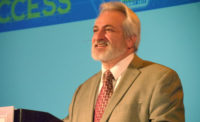The museum, located in Chantilly Virginia, was supported by cooling towers that were old and lacked adequate capacity to serve the building’s increasing cooling load. Site conditions did not allow for a larger cooling tower footprint to meet the increased load. To deliver enough chilled water at peak efficiency and to fix the original hydronic design for the towers, facility managers were faced with elevating the towers by 6 feet. While solving the HVAC system performance challenge, this created a service dilemma: how to safely and efficiently perform routine inspection and maintenance on cooling towers that were 25 feet above ground.
Working with the Smithsonian Institution and AECOM, the engineers at Baltimore Aircoil Company and The Morin Company, the local BAC representative, presented an innovative solution to dramatically improve the reliability of the cooling tower while reducing the need for regular service and maintenance of the fan-drive system.
“Other Smithsonian buildings have incorporated BAC’s towers, and we at AECOM have also worked with BAC in the past,” said Dilip Parikh, P.E., senior project manager at AECOM. “We had seen positive results in these prior projects and the customer support from BAC is superb, so we elected to work with them again.”
The result was a recommendation to replace the existing cooling towers with new cooling tower technology from BAC, which would improve heat rejection capacity and chiller functions. The solution enhanced the capacity of the cooling tower within the existing tower footprint, and most importantly, reduce maintenance requirements.
ENDURADRIVE Fan System Technology Solves Maintenance Concerns
In order to ensure the safety of the maintenance professionals during the life of the cooling tower and a reduction in overall maintenance costs, Parikh and the BAC team decided to replace the traditional fan power transmission with an innovative, simplified direct-drive fan system.
“I knew that direct-drive would likely be the right path for us to take, since we wanted to avoid unnecessary gears or belts that would need to be maintained and replaced,” Parikh said. “BAC then brought their ENDURADRIVE Fan System to my attention, and I immediately recognized that it was a perfect fit.”
Direct-drive fan systems are becoming accepted as the gold standard for high reliability and low maintenance throughout the markets BAC serves. BAC has paced the evaporative cooling industry for more than a decade in applying innovative technologies to factory-assembled, evaporative heat transfer products.
“With more than 500 direct-drive motors installed in the U.S., including in some of the most demanding climates and applications, and with more than 3.5 million operating hours, we knew that the ENDURADRIVE Fan System would provide AECOM and the Smithsonian Institution the peace of mind they needed. Also, by eliminating moving parts, gearbox oil changes, and other routine inspections, fan-drive maintenance costs are cut by 90%” said Stephen Kline, applications manager at BAC.
“When applying the ENDURADRIVE Fan System to traditional cooling towers, our customers enjoy high reliability,” said Kevin Morin, president, The Morin Company. “They also reduce their costs for operating the cooling tower fan motor up to 10% by eliminating the usual transmission losses of gearboxes and belts. We expect their investment will pay for itself in less than 36 months.”
Following the addition of the ENDURADRIVE Fan System, the cooling towers at the National Air and Space Museum’s Udvar-Hazy Center are now capable of meeting the site’s cooling needs with extremely limited maintenance requirements.
“For other companies considering putting a new cooling tower on their own or a client’s building, I say, ‘Go for the ENDURADRIVE Fan System,” Parikh said. “Maintenance is the most important concern — who wants to go up on top of a 25-foot tower or up inside of it to look at gears or the belt drive when something breaks? With the ENDURADRIVE Fan System, that concern is just about eliminated, the efficiency is greater, and even the installation is easier.”
Conclusion
The BAC Series 3000 cooling tower with ENDURADRIVE Fan System was installed at the National Air and Space Museum’s Udvar-Hazy Center at the end of 2018 and has been in continuous operation since then. As expected, BAC’s cooling tower solution has reduced maintenance and increased efficiency for the Smithsonian Institution, and it continues to meet the performance needs of the center.
“BAC sized the new cooling tower with increased capacity while staying within the pre-existing footprint. Since its installation, it has helped enable the HVAC system to maintain precise temperature and humidity, a critical concern in the museum building and research facility,” Parikh said. “Most importantly, the need to climb the tower is rare, so the facilities personnel can remain safe even as the performance of the tower has improved.”
BAC’s innovative solution for the National Air and Space Museum, Steven F. Udvar-Hazy Center met the project’s challenging specifications for increasing cooling tower capacity and has led to dramatically reduced maintenance costs and greater inspection accessibility. Visitors and staff alike will enjoy the benefits of this enhanced cooling tower system for years to come.












